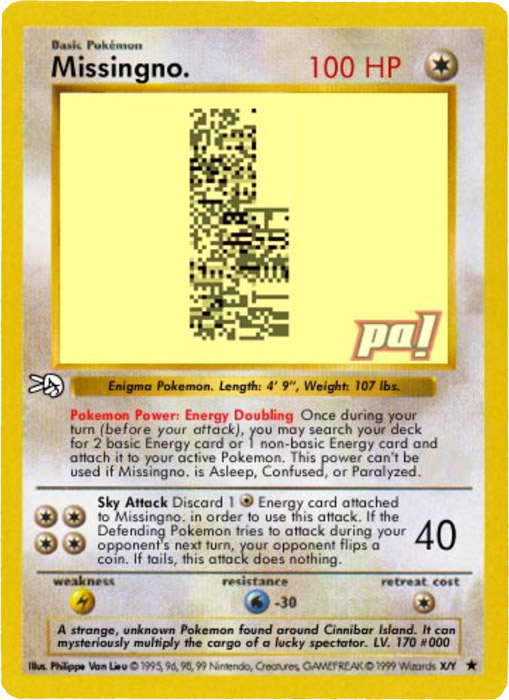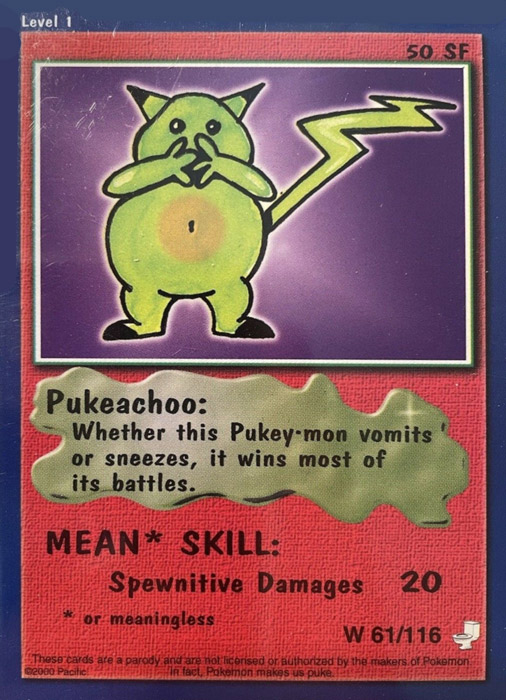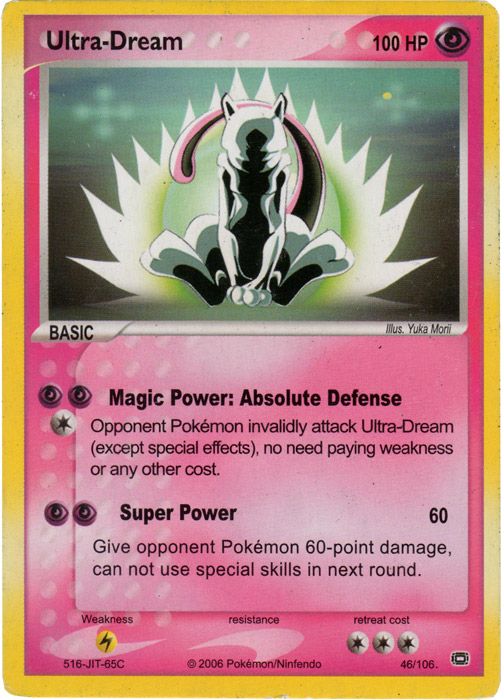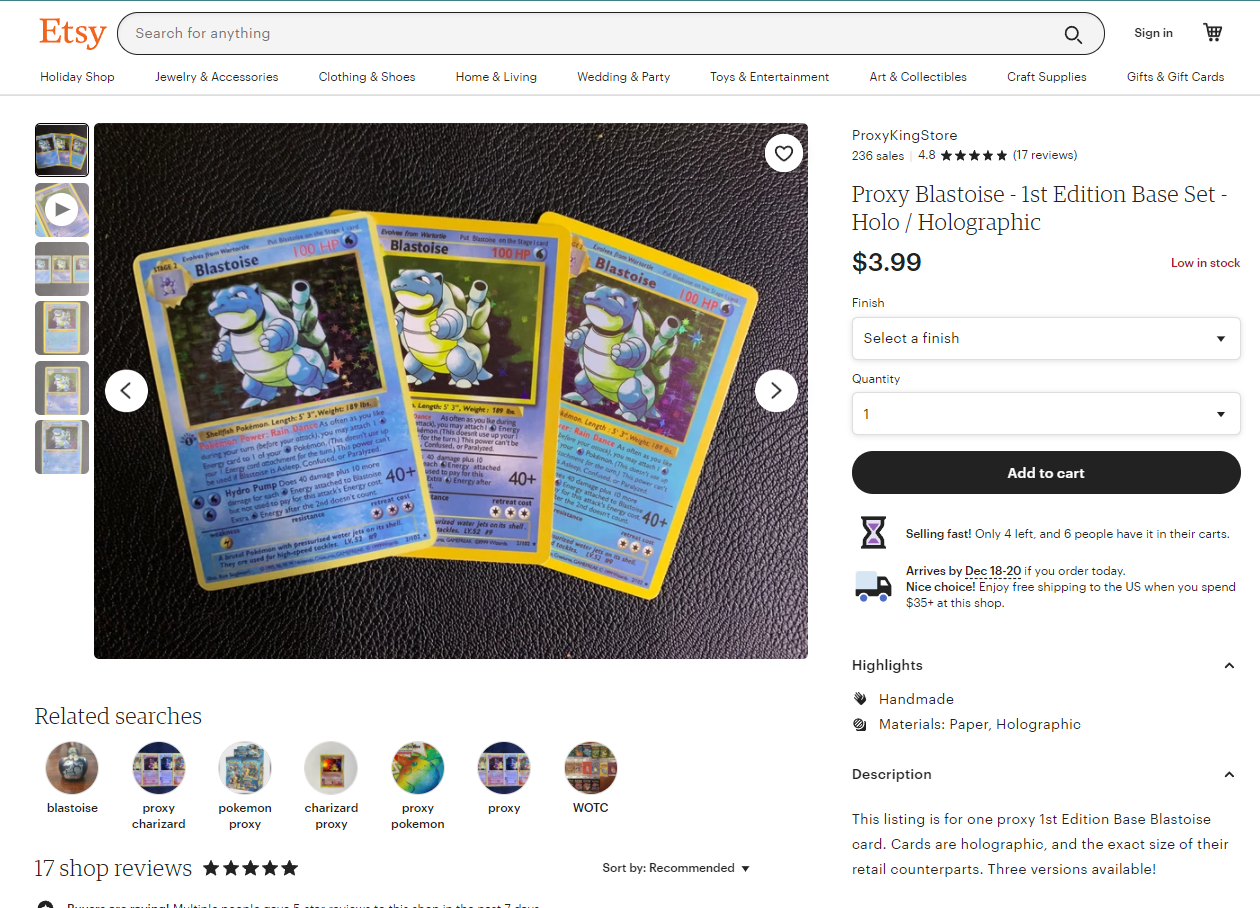The Actual News:

It’s December! … But of course you knew that.
Since this is the season of giving, I’m gonna give it my all and try to focus on fake cards for a while. This may mean that I’ll be focusing less on writing actual news posts and instead updating the various other parts of the site. But even though I already wrote this article, I felt it would be nice to use it as a way to explain my December Focus on Faking. After all, what better way to share with the world my love of making fake cards by actually explaining WHAT “fake cards” are, why the kind WE all make are perfectly 100% legal, and how to distinguish what we do with the stuff that isn’t all that legal. Sound good?
Fake cards can be a large and confusing world, especially when so many different types of “fake cards” exist which in turn lead to all kinds of different ideas about what’s what. So much so that a video like this may lead people to believe that ANY card made by ANYONE would be grounds for the lawsuit happy Nintendo to go after them.
In reality, no. We all know what Nintendo’s track record is like… and actually their track record for Pokémon TCG fakes has been that they’ve NEVER EVER gone after fans. But that doesn’t mean they don’t do after anyone selling FAKE CARDS. It’s just a matter of how “fake cards” are defined, to what degree the fake cards use Nintendo IPs and artwork, etc., and especially what kind of a thorn in Nintendo’s side you can be.
So what exactly are fakes cards then? Well obviously there are authentic cards, as in cards produced or released officially by Nintendo and The Pokémon Company, or Wizards of the Coast between 1998-2003, and their partners and affiliates. Then there are the unofficial or even inauthentic cards, which are cards which were NOT officially released by Nintendo, etc. Within THAT, I would argue that there are three types of unofficial cards:
- fan-made cards
- counterfeit cards
- proxies
Let’s quickly go over each:
But First! A Word About The Law

Since all fake cards are unofficial pieces of work involving the legal copyrights and trademarks of Nintendo, etc, it’s difficult to talk about what’s what without bringing the law into the discussion. Specifically, whether or not a fake card constitutes “fan art”, “fair use”, “parody”, etc, and to what degree?
The thing is, fan art is a tricky business, and is at best (or worst) in a legal grey area. The strange cycle that fans and creators have been in the last 50-plus years is that many famous and established creators actually got their start because of the popularity of their fan art… combined with pure luck that the original rights-holders didn’t go after them. Now when later fan art is made of that established creator’s own work later… they may have the right to go after them, but wouldn’t that look a bit hypocritical? How would their own fans react to seeing their favorite artist acting that way? It feels like this is one of many reasons why companies tend to look the other way concerning fans selling art of their properties.
The main point here is, most companies appear to take a hands-off approach when it comes to fan art. Even Nintendo, surprisingly. They will of course defend their rights when pushed… it’s just that, most of the time, they don’t feel pushed. Now if you want to avoid pushing a rights-holder towards actions, it might be best to follow some of the unwritten rules of fan-art, namely:
- it doesn’t claim to be, or at least can’t be reasonably mistaken for, official authentic merchandise
- it doesn’t use any existing art assets from official merchandise and therefore is 100% fan produced
- it doesn’t interfere with the rights-holders from being able to sell their own products
- it isn’t something that the rights-holders believes will dilute the perceived public value of their property
Long time PA! partner and former staffer, Jen Brazas (aka NeoQueenJen back in the day) has built a rather large fan art empire as “Savage Sparrow“, selling a ton of t-shirts and other merch based on various nerd/geekdom properties, and her experience has basically been that of the above. Because her work doesn’t invoke anything on that list, she’s avoided a lot of C&Ds over the years, although they do come up from time to time. Speaking generally, many C&Ds usually come from the fact that these companies want to maintain an image to uphold in the eyes and minds of consumers, and they would be just as concerned about a fan-project with an uncomfortable connection with their property (eg “Mickey Mouse” adult toys) as they would be about someone is leeching money off the popularity of their products. Alternatively, bonus points are given if the fan art IS something that increases the public perception of the property, like with Andy Warhol’s Campbell’s Soup can paintings; Andy Warhol actually loved Campbell’s Soup but also avoided working with the company, so this is effectively fan-art (no matter how high class it may be).
In the end this is a personal decision. The proliferation of fan-art being sold for profit without the explicit approval of a rights-rightholder can mean one of many things to you: either the fact that everyone does it means that it’s finally normalized and no longer stigmatized and the unwritten ladies-and-gentlemen agreement made by fans with rights-holders strongly implies acquiescence by the rights-holders (so long as those above lines aren’t crossed)…. or it’s a matter of “if everyone jumped off a bridge, is it OK for you to as well”? And then what do you think concerning the law: is the spirit of the law more important to you, or is it the letter of the law which governs what’s right or wrong? I can’t answer any of these for you; instead, it’s just a matter of what kind of person you want to be relative to the others around you.
(FULL DISCLOSURE: I’m not a lawyer, and this post is not intended to be interpreted as legal advice. Rather, it is based on the experiences of myself making fake cards and running PA! since 1999, and of friends and peers working full time selling and producing fan-art in the United States. Fan art in the US is protected under, among other things, 17 U.S. Code § 107 which protect the fair use of copyrighted works, the First Amendment which protects the right of parody as a form of expression, as well as the good graces of the rightful and legal rights-holders who—in most (but not all) cases—simply don’t give two craps. The rights concerning fan-art in other countries may be different, so please do your proper due diligence concerning the laws in your own country. That said, you’ll probably be fine in your country too; I’m actually surprised how many rights-holders really DON’T give two craps about fans profiting off fan-art based on their properties.)
Anyways, back to the point.
Fan-Made Cards
 The first kind of unofficial card is what this site focuses on: unofficial Pokémon TCG cards made by fans for fun and other fan-art related purposes. For this I will use terms like:
The first kind of unofficial card is what this site focuses on: unofficial Pokémon TCG cards made by fans for fun and other fan-art related purposes. For this I will use terms like:
- fake card
- custom card
- fan-made card
- create-a-card
It might be better for me to use just ONE term for the sake of consistency—and especially SEO purposes—but at the same time, each of those terms have all been used at different times over the decades to all mean the same thing. Like, people who aren’t part of the Pokémon TCG fake card community might interpret “fake card” to imply those cheap Chinese knock-off cards, but it’s been used by the community since the beginning to mean “fan-made card”; this is also the source of the word “faking”, meaning “to make a custom card”. But despite that, it still has a slight negative connotation from outside the community, so I’ll most likely use whatever phrase sounds best given the context.
So can you sell fake cards? Basically yes… as long as you keep those fan-art rules in mind. For example:
- anyone buying it must be made aware it’s 100% fan-made and NOT official (tho making a card for your pet or based on some PlayStation or Xbox video game is a good way to make it obvious that it’s unofficial)
- your fake cards does NOT use any symbols or blanks form existing cards (so like your “Colorless” symbol should be a, say, five- or eight-pointed star versus six-pointed)
- the fakes don’t resemble anything that is due to come out such that fans would want to buy YOUR fakes over official releases
- fan-made fakes actually underlines how excited fans are about the Pokémon TCG, or at least doesn’t make official product seem worse
 If you can do that, then you’re golden! Of course if you’re not planning on selling them, then you don’t even need to worry about that. In fact, most of the tools out there for making fakes share those tools as they are under the impression that fakers will use it solely for the fun of making them, not to sell.
If you can do that, then you’re golden! Of course if you’re not planning on selling them, then you don’t even need to worry about that. In fact, most of the tools out there for making fakes share those tools as they are under the impression that fakers will use it solely for the fun of making them, not to sell.
Of course, maybe the EASIEST way to avoid all the questions is by simply making the most obvious of a parody card you can make, like this one that @TheN4Us shared with me on Twitter. Because OBVIOUSLY Nintendo will never be making a poopy-Pokémon card (and therefore this card would never muscle in on Nintendo’s poopy-Pokémon racket). Fortunately you don’t have to go to THIS extreme, but I guess this technically counts! lol
It’s worth noting that OTHER fan products, such as entire fan-produced video game projects, can cross a more lines than fake cards would. Another Metroid 2 Remake (AM2R) is a perfect example of this, as it actually use artwork pulled from official games (like Metroid Zero Mission), it may have interfered with Nintendo’s ability to release their own Metroid 2 Remake (Metroid Samus Returns), and that AM2R was SO GOOD that… well, it might be hard for a random stranger to realize it’s an unofficial game (I mean, how many times have you heard people describe AM2R like “THAT’S a fan game?!”). This is not to say that AM2R is a BAD or WRONG game or that it shouldn’t have been made, it’s just that it had more of a reason for Nintendo to go after it than any fan-made cards you made… at least as long as it doesn’t look like—or could be mistaken for—an official card, doesn’t use official art assets, and doesn’t resemble existing or future products.
Counterfeit Cards
 The second type of unofficial card is something I wouldn’t want to teach anyone how to make: unofficially printed versions of existing Pokémon TCG cards intended to fool unsuspecting customers into believing it’s authentic product. In this case, I would use terms like:
The second type of unofficial card is something I wouldn’t want to teach anyone how to make: unofficially printed versions of existing Pokémon TCG cards intended to fool unsuspecting customers into believing it’s authentic product. In this case, I would use terms like:
- counterfeit card
- bootleg card
- knock-off cards
- cheap/cheapo cards
I consider counterfeit cards to be a whole other world which I won’t exactly be touching much on the site, at least outside of mere discussion or news reporting purposes. Like, Cinnamon on the PA! Discord is building a collection—nay, database—of the various counterfeit and bootleg cards they’ve encountered over the years… so I’ll be dedicating an article about this in the near future. But when it comes to making your OWN bootleg cards, forget it.
The key reason why counterfeit cards themselves would be considered illegal is because it breaks many of the rules of fan-art:
- it’s being sold to fool people into thinking they’re authentic cards
- it almost always uses authentic art assets in their bootlegs—and no, adding three extra zeros to the HP and attacks won’t change that
- it attempts to interfere with Nintendo’s ability to sell cards (as in, people buy the cheaper bootleg and NOT authentic packs)
- the low quality of these knock-off cards may in turn get random people to think ALL official Pokémon TCG cards look just as bad
Remember, most companies look the other way when it comes to fan art because fans don’t operate at such a huge level to actually interfere with legitimate business operations. These counterfeit cards, however, do; they’re pumped out by the millions on cheap cardboard with JUST ENOUGH quality in the printing to fool grandma into thinking they’re real. That money in turn doesn’t go towards fans (who may in turn buy authentic merch in turn) but into the pockets of these operations who… well, let’s just say they won’t be buying any other authentic merch.
So don’t support these guys, don’t buy counterfeit cards. Support your local fan artist instead!
Proxies
Finally, this third type of card is a sort of grey area within a grey area: cards which look like authentic cards buy are bought by people KNOWING they aren’t authentic and are in turn used in place of those authentic cards as a placeholder… a proxy. For this I would likely use words like:
- proxy card
- reproduction card
- replicated card
- substitute card
Proxy cards look close to authentic cards, but are intended to be played by actual players. However, the understanding is that these cards are not authentic from the get-go. Rather, they’re bought in order to ensure their actual, game-legal copy of that card does not get damaged during game-play, or even because they want to be able to play with that card but simply don’t have the funds to get an authentic copy. Frankly, if the other players know it’s a proxy and don’t mind, then there’s no problem. To be honest, it’s a lot better than taking an Energy card and a Sharpie, writing in “Luxray Lv.X” and then assuming my opponent knows what the card is.
This video does a pretty good job of summarizing most fans attitudes about proxies:
Most don’t care! Now as for WHY one needs to use proxies—cards too expensive, etc etc—I won’t get into. Rather, it is a type of unofficial card, but unlike fan-made fakes and counterfeit cards, these unofficial cards serve a wholly separate purpose.

So why are people allowed to make proxies to begin with? Well, most of these games are run by players themselves, and what player hasn’t NOT had a card because they couldn’t afford it and just wanted to play? Even within the rules of fan-art I listed above:
- people buying it know they’re buying a proxy, a replicated card (at least, assuming it’s not someone trying to hock a proxy off as being authentic)
- the fact that it does use authentic artwork is tricky, and maybe the most grey of greys involved…
- proxies don’t interfere with the rights-holders from selling cards because, well, the rights-holders don’t get ANY money from the secondary market to begin with!
- like, if a 1st Edition Charizard sells for $100,000, how much of that did Nintendo get? $3.99, which was the original MSRP of the pack of Pokémon that was originally sold.
- therefore a proxy of a 1st Edition Charizard for $4 interferes with Nintendo’s ability to sell authentic 1st Edition Charizards in literally NO WAY because Nintendo will never sell a 1st Edition Charizard ever again
- it’s hard to determine if proxies strengthen or dilute the perception of the game… but it might be argued that it’s a positive consequence of the actual high value the cards hold on the secondary market
So because proxies serve a niche, and many proxies are of cards that the original game producers will NEVER reproduce ever again, the fact that it uses authentic artwork might not be enough for the original game producers to jump into action. Now it’s not to say that they WOULDN’T, because maybe if a proxy maker gets too-big-for-their-britches and it DOES start to interfere with official business, then certainly the use of authentic artwork would be the main legal argument to stop them. But right now, it’s left alone.
In Conclusion….
So yeah, those were the three different types of unofficial cards that you might encounter, each with varying degrees of legality. Fan-made cards are the LEAST illegal, especially if it uses 100% fan-made assets. Counterfeit cards are the MOST illegal, because they’re produced for the sole purpose to fool people into buying that instead of authentic product. Meanwhile, proxies may be SLIGHTLY illegal, but the rights owners tend to look away because it serves a function given the high price of out-of-print cards on the secondary market.
I hope this was informative for you! Because at least now, when you see someone talking about “fake cards are illegal!” or “Nintendo will sue you for that fan card!”, you can know that it almost certainly won’t be the case.
